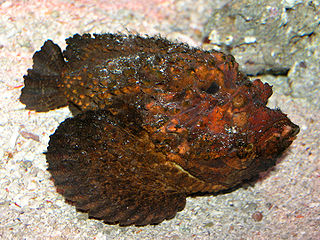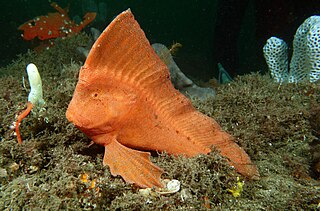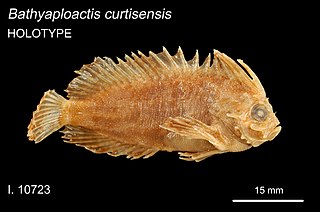
Synanceiinae is a subfamily of venomous ray-finned fishes, waspfishes, which is classified as part of the family Scorpaenidae, the scorpionfishes and their relatives. These fishes are found in the Indo-Pacific oceans. They are primarily marine, though some species are known to live in fresh or brackish waters. The various species of this family are known informally as stonefish, stinger, stingfish and ghouls. Its species are known to have the most potent neurotoxins of all the fish venoms, secreted from glands at the base of their needle-like dorsal fin spines. The vernacular name, stonefish, for some of these fishes derives from their behaviour of camouflaging as rocks. The type species of the family is the estuarine stonefish.

Congiopodidae, commonly known as pigfishes, horsefishes and racehorses, is a family of ray-finned fish classified with in the order Scorpaeniformes. These fishes are native to the Southern Hemisphere.

The Australian prowfishes are a small family, the Pataecidae, of ray-finned fishes classified within the order Scorpaeniformes. Australian prowfishes are distinguished by a long dorsal fin that begins far forward on the head, forming a "prow" shape, and extends all the way to the caudal fin. They lack scales and pelvic fins.

Little velvetfishes or simply velvetfishes are a family, the Aploactinidae, of marine ray-finned fishes classified within the order Scorpaeniformes. They are small fish that have skin with a velvet texture. They live on the sea bottom close to the shore, at depths of up to 100 metres (330 ft). They are found in the Indo-Pacific region.

Apistinae, the wasp scorpionfishes, is a subfamily of venomous, marine ray-finned fishes belonging to the family Scorpaenidae, the scorpionfishes and related species. These fishes are native to the Indian Ocean and the western Pacific Ocean.

The wasp-spine velvetfish, also known as the dwarf velvetfish, is a species of marine ray-finned fish, a velvetfish belonging to the family Aploactinidae. It is the only member of the monotypic genus Acanthosphex. This species is found in the Indo-Pacific from India to the Gulf of Thailand.
The visitor, also known as the sandpaper velvetfish,is a species of marine ray-finned fish, a velvetfish belonging to the family Aploactinidae. It is the only member of the monotypic genus Adventor. This species is found the Pacific Ocean waters along the coasts of Papua New Guinea and Australia.
The dusky velvetfish is a species of marine ray-finned fish, a velvetfish belonging to the family Aploactinidae. It is the only member of the monotypic genus Aploactis. This species is found in the western Pacific Ocean.

The southern velvetfish is a species of marine ray-finned fish, a velvetfish belonging to the family Aploactinidae. It is the only member of the monotypic genus Aploactisoma. This species is endemic to the waters around southern and western Australia.

Bathyaploactis is a genus of marine ray-finned fish, velvetfish belonging to the family Aploactinidae. The genus is endemic to the waters around Australia.

Cocotropus is a genus of marine ray-finned fish, velvetfishes belonging to the family Aploactinidae. The genus is found in the Indian and western Pacific oceans.

Kanekonia is a genus of marine ray-finned fish, velvetfishes belonging to the family Aploactinidae. The genus is found in the western Pacific and eastern Indian oceans.
The threefin velvetfish is a species of marine ray-finned fish, a velvetfish belonging to the family Aploactinidae. This species is found the western Pacific Ocean where it has been found on reefs. This species grows to a length of 5 centimetres (2.0 in) TL. This species is the only known member of its genus.

Paraploactis is a genus of marine ray-finned fish, velvetfishes belonging to the family Aploactinidae. The genus is found the Indo-Pacific.
The deceitful velvetfish is a species of marine ray-finned fish, a velvetfish, belonging to the family Aploactinidae. This species is endemic to the oceans around Australia. This species is the only known member of its genus.
Pseudopataecus is a genus of marine ray-finned fish, velvetfishes belonging to the family Aploactinidae. This genus is endemic to the waters around Australia.
Sthenopus is a monotypic genus of marine ray-finned fish, a velvetfish belonging to the family Aploactinidae. It is found in the western Pacific Ocean where it is known from China and Thailand. The only known member of this genus is Sthenopus mollis.

The whitenose pigfish is a species of marine ray-finned fish belonging to the family Congiopodidae, the horsefishes or pigfishes. It is endemic to the waters off southern and western Australia. It is the only species in the monotypic genus Perryena and the classification of that genus in the family Congiopodidae is not universally agreed upon.

Easchmeyer nexus is a species of marine ray-finned fish; it is the only species in the monotypic genus Eschmeyer and monogeneric family Eschmeyeridae. This fish is only known from the Pacific Ocean, near Fiji.

The whiskered prowfish is a species of marine ray-finned fish, an Australian prowfish belonging to the family Pataecidae. It is endemic to the coastal waters of southern Australia. This species is the only member of the monotypic genus Neopataecus.













